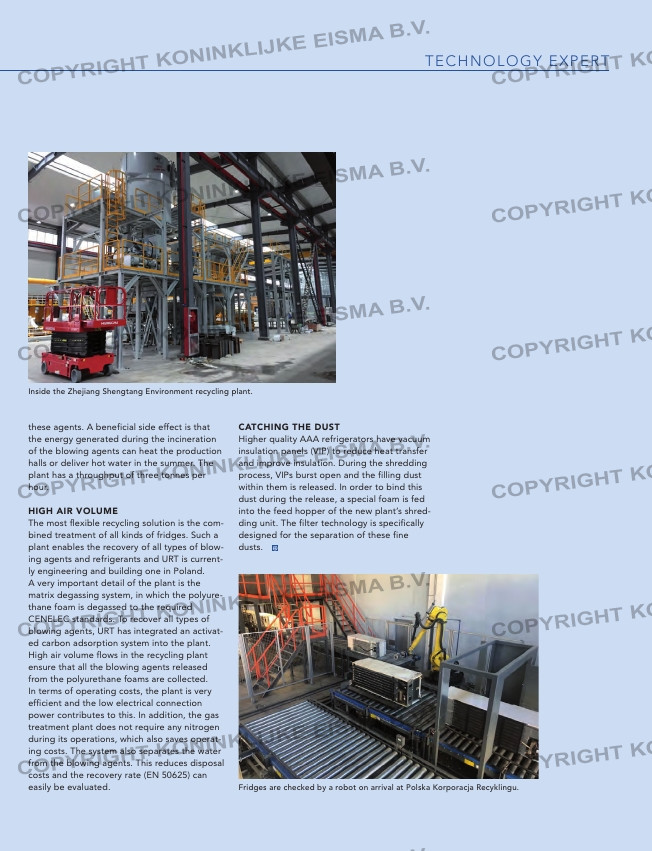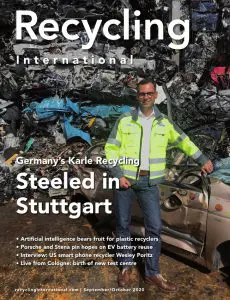Page 23 from: New issue out now!

TECHNOLOGY EXPERT
– Refrigerator recycling
– Small domestic appliance and IT recycling
– Large domestic appliance recycling
– Printed circuit board recycling
– Toner cartridge recycling
– LCD recycling
– CRT recycling
– Sorting of WEEE plastics
Global preSence
Despite the coronavirus crisis, URT has been
building four plants for recycling refrigerators
during 2020. Two of these are for treating
fridges containing volatile hydrocarbons
(VHCs) with online incineration of the blowing
agent pentane. The other two recover all types
of blowing agent. In total, URT has built more
than 50 refrigerator plants. To achieve continu-
ous success in this field, URT’s systems are
constantly undergoing further development
and its processes are adapted to the latest
regulations and standards.
Detecting gases
One of the new plants installed by URT in 2020
is a fridge recycling line at Polska Korporacja
Recyklingu in Lublin, Poland. Another has been
delivered to China. The Polish one, in which
only refrigerators containing the blowing
agent pentane (a VHC) are treated, has been
in operation since July. To ensure that only
fridges containing VHCs enter the system, URT
has developed a detection device integrated
into a robot that automatically analyses the
blowing agent gases in the doors and casings
of the end-of-life appliances.
The advantage of this selective and sustain-
able treatment is very low operational costs
with the risk of explosion reduced by air dilu-
tion. Because the plant requires no nitrogen to
ensure safe treatment of the fridges, opex is
dramatically reduced. Additionally, flammable
blowing agents are burned during the process
so the operator incurs no disposal costs for
these agents. A beneficial side effect is that
the energy generated during the incineration
of the blowing agents can heat the production
halls or deliver hot water in the summer. The
plant has a throughput of three tonnes per
hour.
HiGH air volume
The most flexible recycling solution is the com-
bined treatment of all kinds of fridges. Such a
plant enables the recovery of all types of blow-
ing agents and refrigerants and URT is current-
ly engineering and building one in Poland.
A very important detail of the plant is the
matrix degassing system, in which the polyure-
thane foam is degassed to the required
CENELEC standards. To recover all types of
blowing agents, URT has integrated an activat-
ed carbon adsorption system into the plant.
High air volume flows in the recycling plant
ensure that all the blowing agents released
from the polyurethane foams are collected.
In terms of operating costs, the plant is very
efficient and the low electrical connection
power contributes to this. In addition, the gas
treatment plant does not require any nitrogen
during its operations, which also saves operat-
ing costs. The system also separates the water
from the blowing agents. This reduces disposal
costs and the recovery rate (EN 50625) can
easily be evaluated.
catcHinG tHe duSt
Higher quality AAA refrigerators have vacuum
insulation panels (VIP) to reduce heat transfer
and improve insulation. During the shredding
process, VIPs burst open and the filling dust
within them is released. In order to bind this
dust during the release, a special foam is fed
into the feed hopper of the new plant’s shred-
ding unit. The filter technology is specifically
designed for the separation of these fine
dusts.
Inside the Zhejiang Shengtang Environment recycling plant.
Fridges are checked by a robot on arrival at Polska Korporacja Recyklingu.
22-23_urtumwelt.indd 23 28-09-20 16:28



